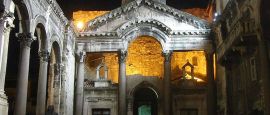Split History
Inhabited for at least 1,700 years, Split’s earliest inhabitants were Neolithic tribesmen, although architectural development began with the Greeks who established a colony on the site of the city. But it wasn’t until the Roman Emperor Diocletian took a shine to the area that the city began to really take shape.
Diocletian, who ruled between AD284-305, decided it was the perfect spot to retire to and built a vast palace, which was inhabited by as many as 10,000 people. Later in the 7th century, as Diocletian's Palace began to become overcrowded, Split began to grow up around it.
Although founded by an emperor and surrounded by the Ottomans, the town remained an independent entity with little outside influence until the 15th century. Between the 15th and end of the 18th century, Dalmatia (and Split) fell under the control of the Venetians. Under their auspices, the city developed into a major port and a hub for trade routes leading into Ottoman-controlled lands.
After the fall of the Venetians in 1797, Split fell briefly under Napoleonic rule before being handed to the Austrian-Hungarian Empire. It remained under the Hapsburgs until WWI brought about the dissolution of Austria-Hungary and a change of ruler for Split.
Dalmatia, along with Split, became a part of the Kingdom of Serbs, Croats and Slovenes, which in 1929 changed its name to the Kingdom of Yugoslavia. Split became a key administrative and cultural centre under the new regime, a state of affairs that continued after WWII. This time, however, the new rulers were the Communists and although the city enjoyed an economic boom courtesy of shipbuilding, personal choice and freedom of speech became virtually non-existent.
In 1991, following the Yugoslavian War, Croatia declared its independence and Split became part of the independent Republic of Croatia. In the years since, Split’s magnificent historical buildings have helped the city get back on its feet and have turned it into a thriving tourist destination. Now the third largest cruise port in the Mediterranean, its future looks assured.
Did you know?
• Diocletian’s Palace took more than 10 years to build with much of the work done by slaves.
• The Cathedral of Saint Domnius is the world’s oldest Catholic cathedral that remains in use in its original structure.
• The granite sphinxes in Diocletian’s Palace were originally from Egypt. They used to belong to Pharaoh Thutmose III.
Do you have any Feedback about this page?
© 2025 Columbus Travel Media Ltd. All rights reserved. No part of this site may be reproduced without our written permission, click here for information on Columbus Content Solutions.




 You know where
You know where